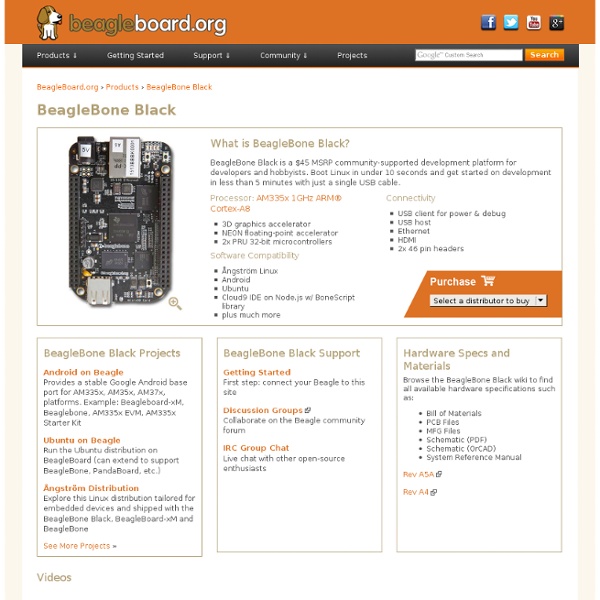What is BeagleBone Black?

Beagleboard:BeagleBoneBlack
This is the official BeagleBone Black Wiki maintained and supported by BeagleBoard.org a non-profit 501(C) organization. If you have any questions or issues with the content on this Wiki, contact Gerald Coley BeagleBone Black Description The BeagleBone Black is the newest member of the BeagleBoard family. It is a lower-cost, high-expansion focused BeagleBoard using a low cost Sitara XAM3359AZCZ100 Cortex A8 ARM processor from Texas Instruments. BeagleBone Black Features The following table lists the key features of the BeagleBone Black. In the box is (1)BeagleBone Black board, (1)USB cable, and (1)card that should be read. BeagleBone Black Picture Here is a picture of the Rev A5A board. BeagleBone Black Key Component Locations Here are the locations of the key components on the Rev A5A. BeagleBone Black Connector and Switch Locations Below is the location of the connectors and switches on the Rev A5A board. Frequently Asked Questions (FAQ) Beaglebone Black FAQ Terms of Use Board Shipments BoneScript
BeagleBone Black ID: 1278 - $45.00
If you liked the BeagleBone, you will love the next gen BeagleBone Black! With a blistering 1GHz processor, 512MB onboard DDR3 RAM, built in 2GB storage with pre-installed Linux operating system (no microSD card required!), and best of all, the addition of a MicroHDMI connector for audio/video output. This is a ultra-powered embedded computer that can fit in a mint tin. Comes with a mini B cable for powering it up ASAP. We'll be filling in with more information on supported accessories as we test them for compatibility. If you need a nice display to go along with your 'Bone, Check out our fine selection of HDMI displays, we've tested all of them with the Beagle Bone Black Matt Richardson has created a teaser video!
Realtime Clock RTC Pi and Beaglebone Black
The RTC Pi can be used with the Beaglebone Black linux computer board Connecting the RTC Pi to the BeagleBone Black Turn off and unplug your BeagleBone Black You also need to add a 2K resistor between the SDA to 3.3V and SCL to 3.3V. The Beaglebone Black needs a lower pullup resistance than the Raspberry Pi. * If you are powering your BeagleBone Black via the USB lead this will need to be connected to pin 7 as pin 5 is only powered via the power socket. Once you have connected the RTC, insert the coin cell before powering on. To verify your wiring by running the following on the command prompt: i2cdetect -y -r 1 The Beaglebone Black will scan the I2C bus and should return the following with 68 being displayed. Now the RTC board has been verified as connected, execute the following: echo ds1307 0x68 > /sys/class/i2c-adapter/i2c-1/new_device Now check the communication between the boards and return the current RTC date and time, execute the following: hwclock -r -f /dev/rtc1 date
BeagleBoard Ubuntu
(For BeagleBoardAngstrom, click here.)(Should Beagleboard:Ubuntu On BeagleBone Black be merged into this page?) This page is about running a Linux distribution (ARM EABI) Ubuntu on the BeagleBoard. BeagleBoard will boot the (ARM EABI) Ubuntu distribution from the SD card. Since much of this page is generic, it has also been extended to help support devices such as the PandaBoard and BeagleBone. For the best experience, make sure you have an LCD/HDMI monitor attached to the BeagleBoard's HDMI port, 2 GB/4 GB/8 GB SD card, and a known good USB 2.0 hub with mouse and keyboard. If you need any help: Ubuntu related help: #ubuntu-arm: Ubuntu's ARM IRC on Freenode (logs -> year -> month -> day -> #ubuntu-arm.html)When requesting help, please provide some debugging information: U-Boot Version installed on board Kernel Version: uname -a pastebin dmesg Copy from serial port or use "dmesg | pastebinit" (sudo apt-get install pastebinit) Mainline U-Boot: boot.scr/boot.cmd changes: With 2.6.35: sudo . . .
Related:
Related:



